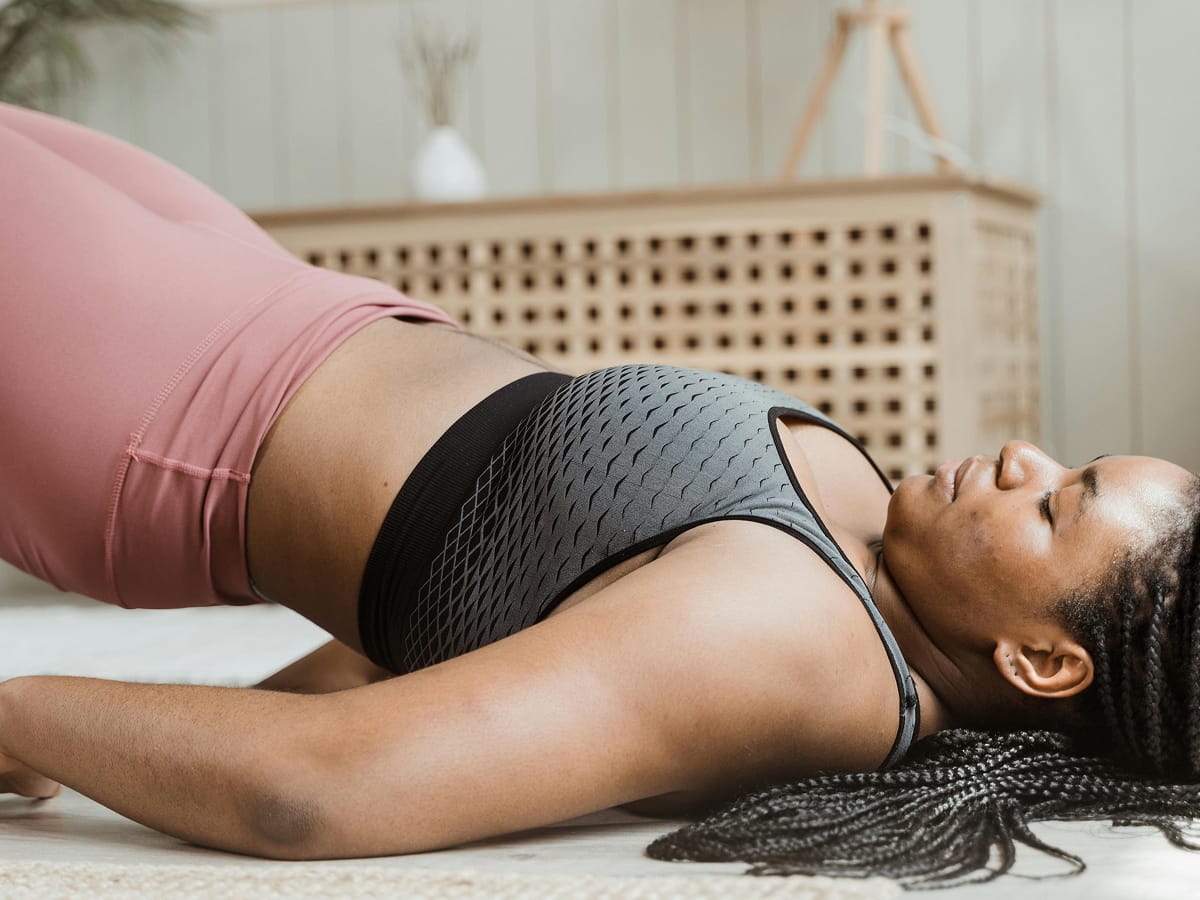How To Exercise For Weight Loss At Home: A Guide For GLP-1 Medication Users

Whether you’re right at the beginning of your weight loss journey using GLP-1 medications or you’re already seeing positive results, it can be a daunting process full of ups and downs.
GLP-1 medications like Wegovy and Mounjaro are helpful tools for supporting weight management because they help to regulate appetite and food intake, leading to significant changes in body weight and overall health.
To maximize your progress and ensure long-lasting results, incorporating movement into your routine can hugely enhance the benefits of using GLP-1s and make sure the weight you’ve worked hard to lose stays off.
Many people find going to the gym, joining group exercise classes or working out outdoors to be intimidating. Exercising at home offers a flexible, accessible way to improve your health without the need to take out an expensive gym membership or feel vulnerable in a public location. Whatever your current mobility or fitness level, this guide will help you start exercising safely, confidently and consistently in a way that feels right for you.
Why Exercise Matters While Using GLP-1 Medication
Combining GLP-1s with physical activity brings a range of additional health benefits:
- Preserves muscle mass while losing fat
- Improves cardiovascular health and endurance
- Boosts mental wellbeing, mood and stress resilience
- Supports better long-term weight maintenance beyond medication
Even simple movements done consistently can make a big impact. Exercise doesn’t have to be high intensity or complicated to be effective—especially when your body is adjusting to medication.
How To Exercise Safely When Using GLP-1 Medication
Before starting or intensifying any exercise plan, it’s important to prioritize safety:
- Check with your healthcare provider if you’re unsure about what’s safe for your condition or current stage.
- Stay hydrated. Sip plenty of water before, during and after workouts.
- Wear supportive footwear to protect your joints and improve balance.
- Monitor your energy. GLP-1s can cause fatigue or nausea in some people, so pace yourself accordingly.
Where To Find Guided Workouts
The Internet is an amazing resource for finding structured, guided workouts. You can search for a whole range of types of exercise, from dance-based cardiovascular routines to gentle chair-based yoga and strength training modified for limited mobility. Explore a range of different options and keep a record of the ones you enjoy most so that you can return to them.
You can also find structured workout plans in books, DVDs, or via apps and websites. Some personal fitness trainers offer online classes for a small fee, so you can experience a live or pre-recorded guided workout in the privacy of your own home. This is an excellent way to bring structure to your workout routine without needing to do any research or planning of your own.
Be sure to incorporate a range of exercises into your workout plan:
- Cardiovascular exercise for heart health and calorie burning
- Strength training to grow muscle mass and support your joints
- Mobility and stretching to aid recovery and increase your range of motion
Getting Started With A New Exercise Routine
The body takes time to adapt to GLP-1 medications, so if you’re new to the treatment you should start with a gentler routine to build your stamina. If you’ve been taking the medication for a few months, your body should be well adjusted and you can start with a more vigorous routine.
Always listen to your body—movement should feel energizing, not exhausting. You’re more likely to feel motivated to keep exercising if you enjoy it. Focus on perfecting your form so you aren’t risking injury. Start with an intensity that feels comfortable and build on that as you grow in confidence.
If you’ve been taking GLP-1s for more than 4 months, but are totally new to exercising, you may want to follow the gentler workout routine to begin with before progressing to the more intense workouts. Choose a regular time of day that works for your routine and stop if you ever feel pain, dizziness, or unusual discomfort.
Level One: For Those New To Exercise, Or In Their First Three Months on Medication
This plan focuses on gentle movement to build confidence, improve circulation, and lay the foundation for increased activity later on. At this stage, mobility may be limited and the body may still be adjusting to the medication. The aim here is to introduce light, low-impact movement that builds confidence with exercise and helps your body adapt without causing discomfort or strain. Even starting with just 5—10 minutes of movement a day is an excellent introduction to movement, and you can increase the duration and intensity on a weekly basis.
Our Expert-Recommended Exercises
1. Chair Exercises
- Examples: Seated leg lifts, seated marches, arm raises with light weights or water bottles.
- Benefits: Promotes circulation, improves joint range, builds strength without stressing the joints.
2. Walking in Place
- Method: Begin with 1–2 minutes, working up to 10–15 minutes as energy and confidence grow.
- Benefits: Cardiovascular support without needing equipment or much space.
3. Wall Push-Ups
- Method: Stand an arm’s length from a wall and press your body towards it using your arms.
- Benefits: Builds upper body strength gently.
4. Gentle Yoga or Stretching
- Examples: Chair yoga, shoulder rolls, seated forward bends.
- Benefits: Eases tension, supports flexibility, and helps relieve stiffness.
5. Mini Resistance Band Workouts
- Method: Use light bands for seated arm curls, leg presses, or lateral raises.
- Benefits: Encourages safe strength building at your own pace.
Level Two: For Those Who Are Already Active, Or Have Been Using Medication For 4+ Months
After a few months of GLP-1 treatment, many users experience increased energy and reduced physical limitations. At this stage, when mobility is improved, the aim is to incorporate moderate-intensity movement to increase stamina, build muscle, and burn more calories.
These exercises are designed to build on early wins with structured, slightly more challenging home workouts. Work up towards 20—30 minutes of activity, 4 times a week. Always listen to your body—if you’re feeling particularly strong and energized, you can increase the intensity. If you’re not, you can take things down a notch or rest.
Don’t forget to begin each session with a warm-up and end with a cool down. Warm-ups should take about 5 minutes, and include a combination of stretching and gentle movement to prepare your body and increase your heart rate gradually. Try marching on the spot, making windmill motions with your arms, and lunging. Cool downs should also take about 5 minutes at the end of a workout, and involve gentle stretching and deep breathing exercises to help with recovery.
Our Expert-Recommended Exercises
1. Bodyweight Strength Training
- Examples: Squats (optionally using a chair for support), standing leg lifts, calf raises.
- Benefits: Builds leg and core strength while improving balance and coordination.
- Increase intensity: Add weights
2. Low-Impact Cardio
- Method: Brisk walking, marching in place, or beginner-friendly aerobic routines.
- Benefits: Boosts heart health and supports ongoing fat loss.
- Increase intensity: Try alternating one minute of jogging on the spot with one minute of walking on the spot.
3. Light Strength Work
- Examples: Dumbbell curls, overhead presses, resistance band rows.
- Benefits: Helps maintain lean muscle during weight loss.
- Increase intensity: Gradually increase the weight as you grow in strength.
4. Dance Workouts
- Examples: Follow-along dance routines or freestyle movement to music.
- Benefits: Fun, uplifting, and great for cardiovascular fitness.
- Increase intensity: Try adding ankle weights or increasing duration.
5. Core Strengthening
- Examples: Seated core twists, wall-supported planks, bird-dog poses.
- Benefits: Supports posture, reduces back strain, and improves stability.
- Increase intensity: Try mat-based core exercises, like sit-ups, elbow planks or Russian twists.
Exercising at home is an empowering way to complement the effects of GLP-1 medications like Wegovy and Mounjaro without the need to join a gym or group workout class. Whether you're starting with chair-based yoga or trying dance routines in your living room, every bit of movement supports your weight loss journey and long-term health.
Remember: there’s no “perfect” plan—only the one that fits your life, your pace, and your goals. Keep things realistic, celebrate every milestone (big or small), and adjust as you go. Don’t be afraid to seek extra guidance from your healthcare provider where you feel like you need it, or take a look at the resources on the ZipHealth blog, which is packed with content for GLP-1 users.
Ready to take the next step in your weight loss journey? Find out what treatment is suitable for you with ZipHealth.
